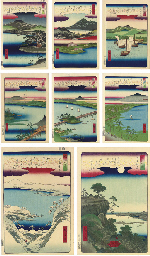Eight Views of ÅŒmi
The Eight Views of Lake Biwa, actually Eight Views of Ōmi (Japanese近 江 八景, " Ōmi Hakkei ") is the title of many image and poem series in which Japanese graphic artist, painter and poet places and landscapes around the Biwa Lake represented in atmospheric images and texts.
Preliminary
The Eight Views were created from the 15th century based on the Chinese " Eight Views of Xiaoxiang ". These relate to the landscape at the confluence of the rivers Xiao and Xiang in the Dongting Lake, an excellent atmospheric area. While the Chinese template places often only defined by the type, such as a fishing village, a fixed set of real places on Lake Biwa in Japan has been formed to 1600. It is located close to Kyoto, where not only the Tennō lived, but also the Ashikaga shogunate had its headquarters in the Muromachi district. In addition, especially the, surrounded by mountains south offers a varied environment. There is no set order in which to below the views to the east beginning to be described in turn. The images shown in the gallery are woodcuts of Utagawa Hiroshige.
The several views,
Autumn moon over Ishiyama
( Ishiyama no Shugetsu ,石山 の 秋月): The Ishiyama Temple is not on the sea, but just south of the discharge, the Seta. As the name Ishiyama ( " Steinberg") says he is built on the slope of a striking rock formation. With its location on the hillside, it resembles the Kiyomizu Temple in Kyoto. A lodge on the edge of the temple grounds affords a view of the lake and the autumn moon. The temple is known also by the fact that according to legend, the lady Murasaki Shikibu in the temple in the year 1000 the novel from the brilliant Genji, the Genji Monogatari wrote.
Evening Snow on Mount Hira
( Hira no Bosetsu ,比良 の 暮雪): The Mount Hira on the western shore of the lake is the highest elevation in the Hira mountain range. In winter, the coming from the Asian mainland monsoon drives the snow at this narrow point in Japan's far into the country.
Returning Sails at Yabase
Yabase is an old port on the eastern shore of the lake. Near the Tōkaidō located, it was used to translate according to Otsu Cities, which could save a few miles the traveler. After 1869 laid there even steamships, but this time was in 1889 at an end, when the railway line Tokyo - Kyoto was finished. Today the port is completely abandoned, there is a park in the heart of industrial plants.
Evening light at Seta
In paintings, this is always the big bridge to see who crosses the Seta taking advantage of a small river island, of course, in the evening light. About this Setagawa -no- Karahashi called bridge was the Tōkaidō. The present bridge is a replica made of concrete, but just in kara = Chinese style, with Giboshi on the railing post.
In the background is the "Fuji of Ōmi ", the Mikamiyama. Although it is only 417 meters high, but actually dominates the area.
Fresh breeze at Awazu
Awazu is known for its pine forest. Awazu -ga- hara between the seta and the place Zeze. In the area fell in 1184 Minamoto no Yoshinaka (born 1154 ) in a dispute with his younger brother Yoshitsune and was buried there. In Zeze the castle of the Honda family stood on a ledge on the Lake Biwa; it is occasionally seen on woodcuts Awazu. In 1870 it was abandoned, today are only sparse remains to be seen.
Evening bell of the Miidera
The Mii -dera was founded in the late 8th century, then expanded later by the priest Enshin 859 to its present importance. The temple has one of the "Three Bells " Japan; she is almost two meters high. It is shrouded in many legends around them, most famously with the strong Benkei ( 1155-1189 ). The present bell was cast, however, only 1602. On the site of a by Ernest Fenollosa temple is buried.
Night Rain on Karasaki
Karasaki is a stone aggregated projection on the edge of lake, on which a single, strikingly large pine - hitotsu - matsu - stands. To a natural monument that includes a shrine. The pine had occasionally be replanted, today dates from the 20th century.
Wassernde wild geese at Katata
Wassernde geese you can not always see there, but rather the small temple, which is deducted from the shore on stilts and is connected to it by a small bridge. The temple in Hokyo style has the name Ukimido. The " uki " is known from the term ukiyo -e, it says " detached drifting on the water." Mido is a name for a temple.
Hira no Bosetsu
Yabase
Seta
Awazu
Miidera
Karasaki
Katata
Hira no Bosetsu ( obtained preliminary drawing Hiroshige )
More " Eight Views " in Japan
The success of his series inspired Hiroshige to produce nearly 20 other series Ōmi Hakkei. But other artists deal with the Eight Views. Hiroshige and other artists then took the issue to other areas of Japan. It just had to atmospheric specifications such as " breeze " suitable locations are found. Thus there are, for example, by Hiroshige the " Eight Views of Edo ", the " Eight Views of Kanazawa ".
Concluding remark
The theme of the Eight Views, the arts and literature in Japan occupied until the 20th century. So, for example, is of Itō Shinsui (1898-1972) a complete series before. The German Max Dauthendey that on a world tour also visited Japan in 1905, it took over and published in 1911 the "Eight Faces at Lake Biwa " which were a great success.



_from_Eight_Views_of_the_Province_Omi_(Omi_Hakkei)_-_Utagawa_Hiroshige_(Ando).jpg)


.jpg)
.jpg)


